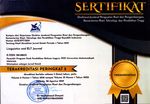The Production of Interdental Fricatives by English as a Foreign Language Students in English Course Bandung
Abstract
Every language has its characteristics in the production of sound. When learning a new language, one probably encountered unfamiliar sounds. For EFL students in Indonesia, they will find it hard to pronounce interdental fricative sound like [θ] and [ð] because, in Indonesian pronunciation, there are no interdental fricative sounds. Therefore, the limited consonant sounds in Indonesian that is not similar become one of the barriers for the students to pronounce the words in English properly. For instance, the words that contain interdental fricative sounds in word-initial position as in 'this' and 'thin', medial as in ‘father’ and ‘authority’, and final part as in ‘booth’ and ‘truth’. Based on this problem, this research attempts to find out and analyze the production of voiceless and voiced interdental fricatives by EFL students in Bandung using the help of software Praat (Boersma, 2001). The data were collected from four students with their voice recordings in pronouncing the words in English that contain an initial, medial and final position of interdental fricative. The result shows that the voiceless interdental fricative [θ] is produced as [d],[t],[th] and elimination of [θ] sound, while the voiced interdental fricative sound [ð] is produced as [d], [t] sounds.
Keywords
Full Text:
PDFReferences
M. Yavaş, Applied English Phonology, 2nd ed. UK: Blackwell Publishing, 2011.
C. Graeppi and A. Leemann, “Between-speaker variation in English Learners’ Realisation of Dental Fricatives.,” Proc. ICPHS Univ. Zurich., pp. 974–978, 2019.
A. Komariah, “Problems in Pronouncing the English Sounds Faced by the Students of SMPN,” J. English Lang. Pedagog., vol. 1, no. 2, pp. 1–10, 2019.
K. Rustipa, “ENGLISH SPEECH SOUNDS [θ, ð], [ ∫, З], [t∫, dЗ ]: HOW ARE THEY REALIZED?,” Din. Bhs. Dan Budaya, J. Pengemb. Bhs. dan Budaya, vol. 3, no. 2, pp. 152–170, 2009.
A. Cruttenden, Gimson’s Pronunciation of English, 7th ed. London: Edward Arnold, 2008.
N. Silbert and K. De Jong, “Focus , prosodic context , and phonological feature specification : Patterns of variation in fricative production,” J. Acoust. Soc. Am., vol. 123, no. 5, pp. 2769–2780, 2008.
M. Hismanoglu, “The pronunciation of the inter-dental sounds of English: an articulation problem for Turkish learners of English and solutions,” Procedia - Soc. Behav. Sci., vol. 1, no. 1, pp. 1697–1703, 2009.
T. S. Bui, “PRONUNCIATIONS OF CONSONANTS / ð / AND / θ / BY ADULT VIETNAMESE EFL LEARNERS,” ndonesian J. Appl. Linguist., vol. 6, no. 1, pp. 125–134, 2016.
A. Hanulíková and A. Weber, “Production of English interdental fricatives by Dutch , German , and English speakers,” no. 2014, 2010.
D. Hattem, “Substitution Patterns for English Inter-Dental Fricatives by L1 Latin American Spanish-Speakers,” 2009.
S. K. Bogdan, R. C.; Biklen, Qualitative research for education: An introduction to theory and methods. Boston: Allyn and Bacon, Inc., 1982.
J. W.Creswell, Research Design: Qualitative, Quantitative, and Mixed Methods Approaches), 4th Editio. USA: SAGE Publicatons, Inc., 2014.
P. Boersma and D. Weenink, “Praat: doing phonetics by computer.” 2018.
M. B. Miles, A. M. Huberman, and J. Saldana, The Analysis of Qualitatitive Data, 3rd Editio. USA: SAGE Publications, Inc, 2014.
V. Fromkin, R. Rodman, and N. Hyams, An Introduction to Language (9th edition - International Edition). 2011.
J. Harrington, “Acoustic Phonetics,” in The Handbook of Phonetic Sciences, John Wiley & Sons, 2012, pp. 81–129.
DOI: https://doi.org/10.31764/leltj.v8i1.2546
Refbacks
- There are currently no refbacks.
Copyright (c) 2020 Linguistics and English Language Teaching Journal

This work is licensed under a Creative Commons Attribution-ShareAlike 4.0 International License.
_____________________________________________________
Linguistics and ELT Journal
p-ISSN 2339-2940 | e-ISSN 2614-8633

LELTJ is licensed under a Creative Commons Attribution-ShareAlike 4.0 International License.
_____________________________________________________
LELTJ is abstracting & indexing in the following databases:
_____________________________________________________
LELTJ Editorial Office:













